Understanding Leopard Gecko Dietary Habits and Needs
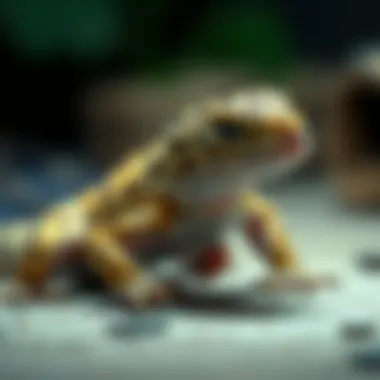
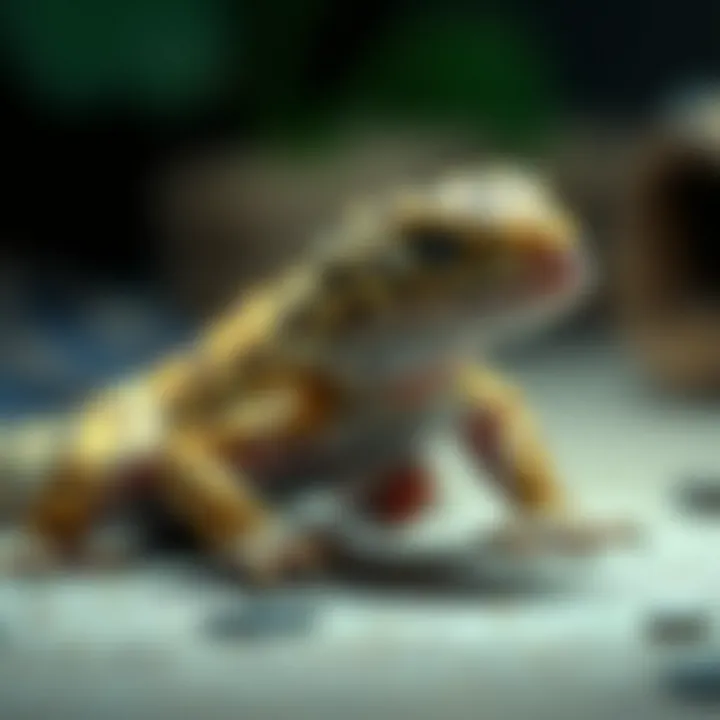
Intro
When you think about pet reptiles, leopard geckos often come to mind. Their charming personalities, vivid colors, and easy care routines make them a popular choice among reptile enthusiasts. But beneath that appealing exterior lies a critical aspect every owner needs to grasp—their dietary habits. Understanding what these creatures naturally consume and how to replicate their diet at home is essential for healthy, thriving pets. In this article, we will navigate through the world of leopard gecko nutrition, exploring what makes their diet unique, why it matters, and how you can ensure your little friend’s well-being.
Pet Care and Grooming
This section may address feeding indirectly, given that good nutrition and proper care go hand in hand. Leopard geckos require regular upkeep to stay in optimal health, making their care choices all the more vital.
Importance of Regular Care
Just like fine wine, leopard geckos need careful attention. Proper care routines help prevent health issues that stem from dietary neglect. Regular cleaning of their habitat is necessary to fend off bacteria and mold that could spoil their food supply. Engaging with them through gentle handling also nurtures a bond and helps with socialization, making feeding times calmer and more enjoyable.
Grooming Techniques by Pet Type
While leopard geckos don’t require extensive grooming like furry pets do, you should still keep an eye on their skin condition. Ensure that they are shedding correctly; any retained skin may indicate problems. A light misting of their environment may assist in a successful shed, while gentle handling can help mitigate stress during this time.
Tools and Products Recommendations
When it comes to gear, some items can ensure a better experience for both you and your gecko. Essential tools include:
- Feeding Tongs: For precision when delivering live insects.
- Humidity Gauge: Helps monitor habitat conditions necessary for shedding.
- Temperature Thermometer: Ensures their environment remains within the ideal range.
- Substrate Choices: Options like reptile carpet or paper towels help keep a clean habitat that aligns with their dietary needs.
Seasonal Care Tips
Understanding your gecko's behavior during different seasons can also inform their care. In winter, they may become less active, which could lead to a decreased appetite. During these periods, adjusting the feeding frequency and slightly lowering their portion sizes can keep them healthy without a sudden change in their diet.
Health and Nutrition
Now, let's get to the core of the matter—what fuels our leopard geckos and how to ensure they’re receiving a well-rounded diet.
Understanding Pet Nutrition
Leopard geckos are classified as insectivores, which means their primary source of nourishment is insects. In the wild, they feast on crickets, mealworms, and roaches. Replicating this diet at home is key to maintaining their health. Variety is the spice of life; mixing up the insects offered can provide essential nutrients.
Common Health Issues by Species
While leopard geckos are generally hardy, certain health concerns stem from poor nutrition:
- Metabolic Bone Disease: Caused by calcium deficiency, leading to severe health complications.
- Obesity: Overfeeding or too sedentary due to lack of exercise may lead to weight gain.
- Impaction: A common effect of ingesting substrate; staying away from loose substrates can help prevent this.
Preventive Care and Regular Check-Ups
It's prudent to schedule yearly check-ups with a reptile vet. They can help identify any dietary deficiencies early on and provide tailored advice. Keeping track of their weight can also indicate if they're consuming the right amount of food for their growth stage and health needs.
Food and Dietary Advice
In the context of feeding leopard geckos, here are some practical tips:
- Offer food daily, particularly for younger geckos, to foster growth.
- Adult geckos can be fed every other day, considering their activity level.
- Always dust insects with calcium and multivitamin powders a few times a week to ensure balanced nutrition.
Resources and Community Engagement
For those looking to deepen their understanding or connect with other leopard gecko enthusiasts, several resources can offer further insight.
- Recommended Books: "Leopard Gecko Care" by Michael J. J. Lee
- Websites: Visit sites like reptilesmagazine.com and thegeckoranch.com for in-depth articles and care guides.
- Communities: Online forums such as reddit.com/r/leopardgeckos provide invaluable support and shared experiences among gecko owners.
By wrapping your head around the dietary habits of leopard geckos, you can make informed decisions that will positively impact their life. Understanding their needs is not just beneficial but also rewarding, ensuring your scaly companion lives a long, healthy life.
Intro to Leopard Geckos and Their Nutritional Needs
The focus on nutritional needs encompasses several facets, including their natural tendencies as insectivores and the types of prey that suit them best. Given that leopard geckos are predominantly insect eaters, it is vital for pet owners to grasp the significance of providing a diet that mirrors their natural foraging behavior. An understanding of how to meet these dietary considerations offers a pathway to maintain their health and vitality.
Additionally, a keen eye on their feeding patterns and preferences can help avoid common pitfalls, such as nutritional deficiencies or feeding disorders. As leopard geckos navigate their environments, they may display unique feeding instincts that, when respected and understood, can enhance their overall living conditions. This article will delve into these aspects, extending a comprehensive understanding not just for current pet owners but also for prospective adopters and animal enthusiasts alike.
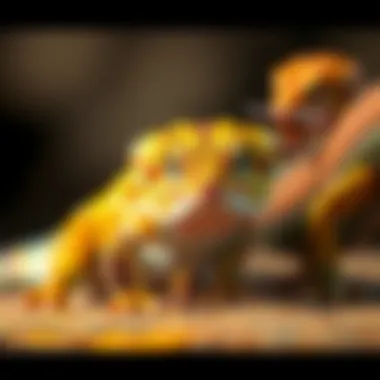
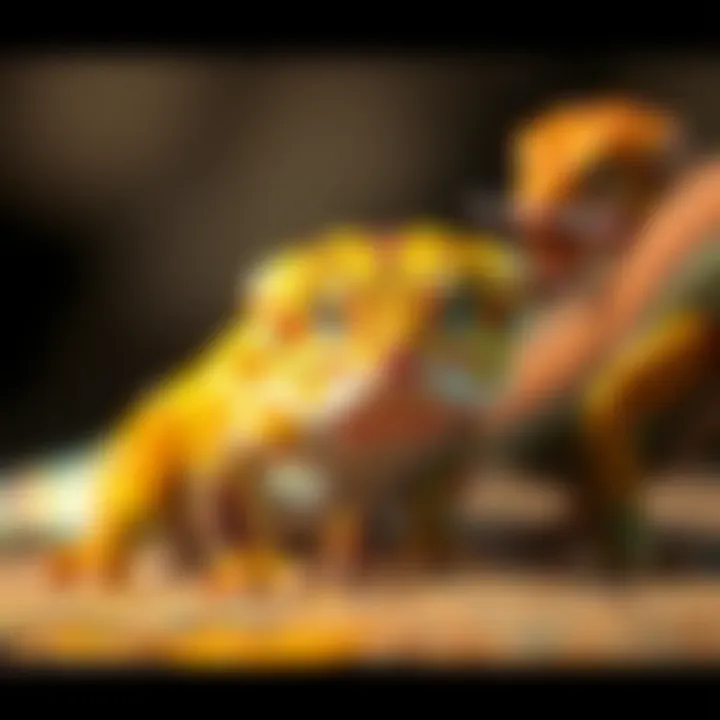
Overview of Leopard Geckos
Leopard geckos, scientifically known as Eublepharis macularius, are nocturnal reptiles originating from the dry and rocky terrains of South Asia, primarily in regions like Afghanistan, Iran, and parts of India. Their unique spotted patterns, which mimic the appearance of wild leopards, serve as an evolutionary advantage in their natural habitat, allowing them to blend seamlessly into their surroundings for better camouflage against potential predators.
In captivity, these geckos have gained significant popularity due to their relatively easy care, docile nature, and impressive longevity, often reaching ages of 10 to 20 years with proper maintenance. Furthermore, their resilient disposition makes them suitable for both novice and experienced reptile enthusiasts.
Understanding Insectivorous Diets
The term 'insectivorous' refers to animals that primarily consume insects as their main dietary source. For leopard geckos, this means that a diet comprising of various live insects is crucial to meet their nutritional requirements.
In a natural setting, these geckos would actively hunt a range of insects, including crickets, grasshoppers, and various beetles. In doing so, they not only secure sustenance but also engage their natural instincts, which play a vital role in their mental and physical well-being. The 'hunt' activates their predatory behaviors, and replicating this experience in a captive environment can lead to happier, healthier animals.
It's important to understand that while diet diversity is key, not all insects are created equal nutritionally. Some insects might lack the essential nutrients that leopard geckos need. Thus, choosing the right kind of prey—rich in protein and free of harmful chemicals—becomes a cornerstone of responsible pet ownership.
By maintaining a diet that adheres closely to their natural preferences, leopard geckos can thrive, leading to increased energy levels, proper growth, and disease resistance. Recognizing the importance of an insect-based diet lays the groundwork for this entire exploration into their feeding habits, showcasing how proper nutrition aligns with their instinctual behaviors and overall health.
Typical Diet of Leopard Geckos
Understanding the typical diet of leopard geckos is crucial for those who wish to keep these fascinating creatures as pets. These reptiles thrive primarily on insects, making it essential to select appropriate prey that not only satisfies their hunger but also meets their nutritional needs. An insight into their dietary habits helps pet owners ensure good health, vibrant colors, and overall well-being in these geckos.
Proper feeding habits impacts growth and longevity. Getting the diet right lays the foundation for a happy gecko, minimizing the likelihood of problems down the line.
Common Prey Options
When it comes to feeding leopard geckos, several prey options stand out, each with their own merits and drawbacks.
Crickets
Crickets are arguably the most popular choice for leopard geckos. These agile little insects last relatively long in captivity, giving gecko owners flexibility in feeding schedules. Their high protein content makes them a valuable source of nourishment. Crickets are rich in moisture, helping to keep hydration levels up, which is essential in any lizard’s diet.
However, they can do a dance of darting around the enclosure, which sometimes sends a gecko into a frenzy of hunting. It's worth noting that over-reliance on crickets may lead to nutritional deficiencies; they aren't as rich in calcium as some other options.
Mealworms
Next up are mealworms. These satisfyingly plump larvae are known for their high-fat content, making them a hit among leopard geckos, especially those needing a boost during breeding season. Mealworms have a distinct texture that geckos find appealing, and their slower agility allows for an easier hunting experience.
On the flip side, mealworms are not the best source of nutrition for regular feeding. Their fat content can lead to obesity if offered too often, which can create health problems later on.
Waxworms
Waxworms deserve a mention as a treat rather than a staple in the diet. These worms are sweet and high in fat, which can tempt even the pickiest gecko into a feeding frenzy. Their soft body makes them easy to consume, making them a great choice for enticing geckos that might be feeling under the weather or refusing regular food.
Yet, the high fat content can be a double-edged sword. They should be used sparingly to prevent unwanted weight gain and nutritional imbalances.
Superworms
Lastly, superworms are another substantial option. These long, meaty larvae are closer to the top tier of prey options for leopard geckos. Rich in protein and packed with goodness, they offer a great source of energy for these critters. Geckos often enjoy the challenge of catching these feisty worms due to their robust movements.
However, superworms can pose their own problems. Their tough exoskeleton can be difficult for young or smaller geckos to digest properly, so caution is warranted when introducing these into the diet.
Nutritional Value of Common Prey
Understanding the nutritional value of commonly offered prey is salient for providing leopard geckos with a balanced diet.
- Crickets provide a good balance of protein and moisture but are low in calcium.
- Mealworms bring the fats and flavors but need moderation in frequency to avoid health risks.
- Waxworms offer a high-energy treat but should only be a rare indulgence.
- Superworms have high protein values but might be tough for certain geckos.
Paying attention to nutritional value not only guides better feeding practices but also significantly supports the well-being of leopard geckos over time.
For further informational resources, consider checking out Wikipedia on Leopard Geckos or pet care platforms like Reptiles Magazine.
Feeding Strategies for Leopard Geckos
Feeding strategies represent a cornerstone in the overall health and happiness of leopard geckos. It's not merely about tossing in a few crickets and calling it a day. Instead, understanding how often to feed, how much to serve, and how to enhance their diet with vitamins and minerals can significantly influence their growth, energy levels, and longevity. Just as a well-cooked meal can differ from a quick snack for humans, the same holds true for leopard geckos.
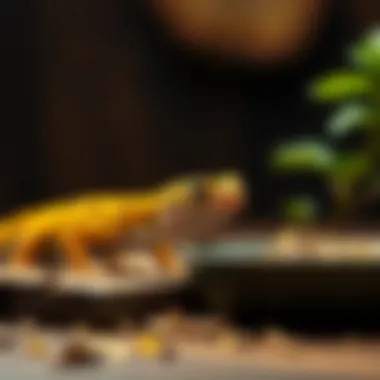
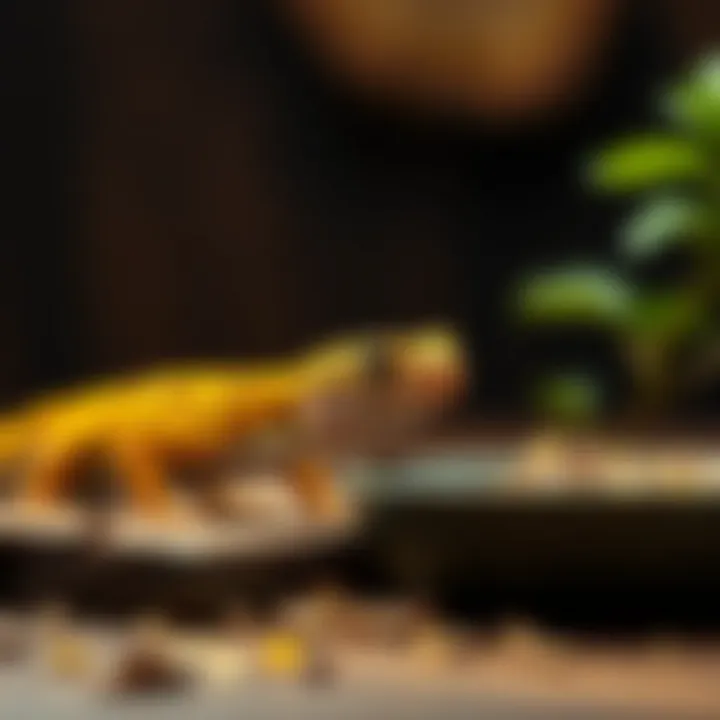
Frequency of Feedings
The frequency of feedings is essential for maintaining a leopard gecko’s health. Typically, young geckos require feeding more often than adults due to their rapid growth rates. It's not uncommon for hatchlings and juveniles to need food daily, while adult leopard geckos thrive on a feeding schedule that can be reduced to every two or three days.
Keeping consistency helps them regulate their metabolism and maintain healthy body weight. An adult gecko that's overfed can become lethargic and may face health repercussions. On the flip side, underfeeding might stunt growth and weaken their immune system. As a rule of thumb, monitor your gecko. If they start becoming overly round, it might be time to cut back a bit.
Portion Sizes and Age Considerations
When discussing portion sizes, we must consider a gecko’s age, size, and activity levels. For young geckos, offering insects that are about the size of their head can be a good starting point. This rule ensures they can easily hunt and consume their food without struggling. Conversely, adult geckos, being more robust, can tackle larger prey.
Pay attention to the gecko's behavior regarding portion sizes. A healthy gecko will actively hunt down its food. If you notice it leaving leftovers consistently, it may be a sign that you’re serving too much. Similarly, a gecko that finishes its meal within minutes is likely ready for more substantial portions. Adjust accordingly, but always prioritize quality over quantity.
Supplementing Diets with Vitamins and Minerals
To keep leopard geckos in tip-top shape, it's essential to supplement their diets with vitamins and minerals. Even the most meticulous diet can lack certain nutrients that are vital for their health. This is where supplements come into play, particularly calcium and vitamin D3.
Calcium aids in bone development while vitamin D3 ensures that calcium is properly absorbed. A good practice is to dust the prey with calcium powder at every feed, with a focus on vitamin D3 supplementation a couple of times a week. Too much of a good thing can be harmful, so it’s crucial to follow recommended guidelines.
"A hibby go a long way when it comes to keeping your gecko healthy; too little or too much can spell trouble."
To sum up, feeding strategies for leopard geckos encompass a holistic approach involving the frequency of feedings, appropriate portion sizes based on age, and careful supplementation with vitamins and minerals. Combining these components leads to a thriving leopard gecko that exhibits energetic behaviors and overall wellness. Remember, understanding their needs and instincts can transform feeding time into a more fulfilling experience for both the gecko and the owner.
Observing Feeding Behaviors
Observing the feeding behaviors of leopard geckos is a gate way to understand their intricate dietary habits. This section is vital because it sheds light on how these reptiles engage with their food, which ultimately reflects their health and well-being. When pet owners know what signs to look for, they can adjust diets accordingly, ensuring their geckos thrive. Additionally, comprehension of a leopard gecko’s natural predatory instincts allows for a more fulfilling feeding experience, enhancing the bond between the gecko and its owner.
Natural Instincts in Hunting
Leopard geckos are instinctual hunters, a trait that roots back to their wild ancestry. Observing these instincts can provide enlightening insights into what drives their feeding habits. In the wild, these reptiles rely on movement-sensitive reflexes to catch prey, primarily insects. Pet owners should create a feeding environment that mimics this hunting experience as closely as possible.
For instance, live prey like crickets or mealworms should be offered in a spacious terrarium where the geckos can stalk and chase them. This behavior not only provides mental stimulation but also encourages natural hunting patterns. If you notice your gecko eagerly chasing after prey, it’s a good sign that they’re both mentally and physically engaged.
In contrast, if your gecko is lethargic or disinterested during feeding, it might indicate that they aren't receiving appropriate stimulation or that their diet needs adjustments.
Recognizing Appetite and Feeding Cues
Recognizing when a leopard gecko is hungry is crucial for maintaining a proper feeding routine. These reptiles communicate their appetite through various cues, which can be subtle but are essential for any conscientious pet owner to note. Signs of hunger can include an increase in activity levels within their habitat, sudden interest in their surroundings, or even standing in a specific spot where food is normally served.
Some geckos exhibit more extreme behaviors, such as vigorous tail waving or pacing in the vivarium when they scent food.
Monitoring these behaviors closely will help in establishing an efficient feeding schedule. If a leopard gecko seems consistently disinterested in food, it could be a sign of stress, health issues, or simply a bored palate. To address this, one might consider introducing a variety of insects or utilizing different feeding techniques, such as varied feeding times or presentation styles, to incite the gecko’s interest.
Common Dietary Challenges
When it comes to taking care of leopard geckos, they can be a bit tricky sometimes. Understanding common dietary challenges helps pet owners make informed decisions about feeding. This section dives into the two main troubles that often crop up: dealing with picky eaters and the risks of imbalanced diets. Getting a handle on these challenges is not just about keeping the gecko satisfied—it’s about ensuring they live long, healthy lives.
Dealing with Picky Eaters
Identifying Causes of Reduced Interest
Leopard geckos are notorious for their selective tastes. If a gecko suddenly begins to show disinterest in food, it’s crucial to identify the reasons why. There can be many causes behind this lack of appetite, ranging from environmental stressors to health issues.
- Environment: If the temperature or humidity isn’t on point, geckos may refuse food. They thrive in specific climates; if you notice them avoiding the plate, it could be a call to check their habitat.
- Health Issues: Illness could also be a factor. Signs like lethargy or unusual behavior alongside reduced interest can indicate underlying problems.
- Dietary Changes: Sudden shifts in diet or even the introduction of new prey types can make a gecko suspicious of food.
Identifying these causes helps in adjusting their diet or habitat, all of which can aid in coaxing them back to their meals. Recognizing the root cause is much better than just trying random foods.
Strategies for Encouragement
Once the causes are pinned down, pet owners have to think about how to entice their geckos back to eating. Some effective strategies can really make a difference:
- Experiment with Favorites: Sometimes, bringing back an old favorite can rekindle interest. Restructuring feeding choices to include previously enjoyed insects may stir up their appetite.
- Change the Feeding Environment: A fresh feeding location might just pique their curiosity. Switching up the scenery from an enclosure to a different spot could reduce stress during mealtime.
- Try Different Feeding Techniques: Hand-feeding or using feeding tongs can also add a bit of novelty to their feeding routine, making it more interactive and engaging.
These methods may require patience, but it’s well worth the effort! Encouraging healthy eating habits through these techniques lays the groundwork for better nutritional intake moving forward.
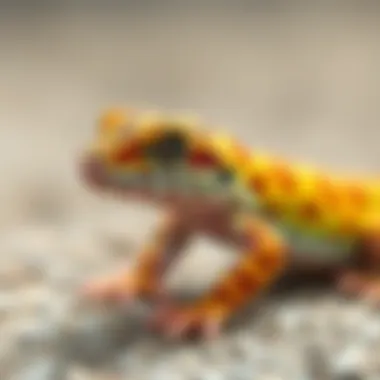
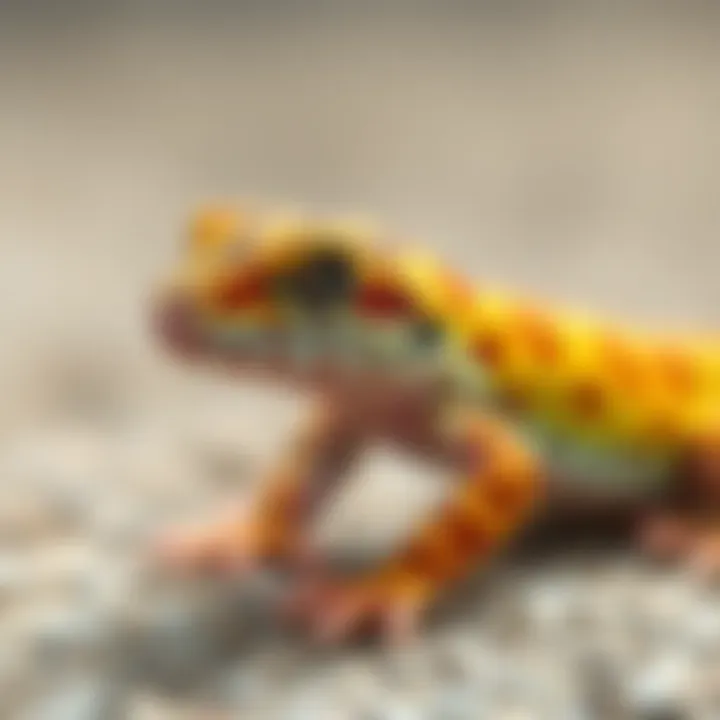
The Risks of Imbalanced Diets
Feeding leopard geckos a balanced diet is crucial. An imbalanced diet can lead to a host of problems down the line. It’s imperative that owners are aware of the common pitfalls.
- Nutritional Deficiencies: Lack of calcium or other vital vitamins can result in metabolic bone disease, which horrifies anyone who wants their pet healthy.
- Obesity Issues: Overfeeding, especially high-fat insects like waxworms, can lead to weight issues, making them sluggish and bringing on health complications.
- Dehydration Risks: Sometimes, not enough variety can mean they’re not getting sufficient moisture. This wouldn’t end well for any gecko.
Therefore, attention to dietary balance plays a significant role. It is often more than just feeding—it’s about nourishing and nurturing your gecko's life in a way that health comes first.
Health Implications Linked to Diet
Proper nutrition plays a crucial role in the overall health and well-being of leopard geckos. Understanding the ramifications of dietary choices helps in ensuring that these exotic pets thrive. Various health issues can arise from poor dietary habits, and being proactive can prevent long-term effects that might be distressing for both the gecko and its owner. This section aims to shed light on the signs of nutritional deficiency and the potential long-term effects of inadequate diets, ultimately helping owners to maintain robust health for their leopard geckos.
Recognizing Signs of Nutritional Deficiency
When it comes to leopard geckos, subtle behavioral and physical signs can indicate nutritional deficiencies. Owners should watch for the following red flags:
- Weight Loss: A noticeable drop in weight could signal inadequate nutrition and needs immediate attention.
- Lethargy: If the gecko seems sluggish and less active than usual, it may be lacking essential nutrients.
- Changes in Skin Quality: Dull, dry, or shedding skin can indicate vitamin deficiencies.
- Bone Deformities: Metabolic bone disease, a serious condition stemming from calcium and vitamin D3 deficiencies, can lead to visible deformities or weakness in limbs.
- Poor Appetite: A sudden or uncharacteristic refusal to eat should not be brushed off; it’s often a sign that something is amiss in their diet.
Knowing these signs allows pet owners to act quickly and seek advice from a veterinarian to make necessary changes in diet.
Long-term Effects of Poor Nutrition
Over time, insufficient or imbalanced diets can lead to a variety of health complications that could shorten a leopard gecko's lifespan. Here are some long-term effects worth considering:
- Metabolic Bone Disease: As mentioned earlier, a lack of calcium and vitamin D3 can cause skeletal problems that may not heal even with diet correction later.
- Weak Immune System: Insufficient nutrition weakens the gecko's ability to fight off diseases, leading to frequent illnesses which could be easily prevented with a balanced diet.
- Impaired Growth: Young leopard geckos require adequate nutrition to grow properly. A poor diet may result in stunted growth, significantly affecting their development.
- Digestive Issues: Prolonged poor nutrition might lead to issues like constipation or malabsorption, resulting in further health complications.
"For leopard geckos, recognizing the signs of nutritional deficiency and understanding the potential long-term effects of poor dietary habits is key to fostering a vibrant, healthy companion."
Taking the time to educate oneself about these concerns is a significant step in providing a longer, healthier life for a leopard gecko. Keeping a watchful eye on their diet and adjusting as required can make all the difference.
Creating an Optimal Feeding Environment
Creating a suitable feeding environment for leopard geckos is crucial for their health and well-being. This space not only caters to their feeding habits but also ensures that they’re less stressed while eating. When you create a calm atmosphere, it mimics their natural habitat, enabling them to engage in instinctive hunting behaviors. Here’s why it matters:
- Reduction of Stress: A well-designed area reduces stress during feeding, as leopard geckos can feel threatened by environmental factors.
- Hygiene and Cleanliness: Setting up a dedicated feeding space helps maintain cleanliness, preventing any leftover food from spoiling and affecting their health.
- Encouraging Natural Instincts: Aiming for a more natural setup allows the reptiles to exhibit their innate hunting behaviors, which can make feeding a more enriching experience.
Setting Up the Feeding Space
When arranging the feeding area for leopard geckos, you want to strike a balance between practicality and creating a comfortable environment. The first step is to identify a spot within their habitat that’s not too cramped yet provides enough security. Here are some practical steps to setting up the area:
- Choose a Flat Surface: Picking a flat surface is critical. It keeps the food steady and prevents it from rolling away.
- Avoid Overcrowding: Space matters for their emotional health. Keep the area clear from other terrarium décor that may act as distractions.
- Create Hiding Spots: Since these geckos feel secure in hiding spots, ensure your feeding space is not completely exposed. A small hide nearby can serve as a safety net while eating.
Establishing these elements ensures leopard geckos will feel less vulnerable and more inclined to hunt and eat comfortably.
Choosing Feeding Accessories
Selecting the right feeding accessories goes hand-in-hand with setting up your leopard gecko’s dining area. The tools you use can significantly impact their feeding behaviors. Look for:
- Feeding Dishes: Opt for shallow dishes that make it easy for geckos to access their food. Deep bowls may confuse them and lead to feeding issues.
- Tweezers for Live Food: Having a pair of feeding tweezers can be handy when offering live insects. It mimic hunting and prevents escapee insects from eluding the gecko's grasp.
- Calcium and Vitamin Supplements: Using small containers for these powders can help dispense them effectively without making a mess.
By paying attention to both the feeding space and the accessories for your leopard gecko, you help create a comfortable and effective dining experience. This careful consideration plays a vital role in their overall nutrition and health.
Finale and Best Practices
Summary of Key Points
To recap the crux of what we've covered:
- Natural Diet: Leopard geckos are insectivores, requiring a variety of insects such as crickets, mealworms, and waxworms to thrive. Their nutritional health hinges on the diversity and quality of prey.
- Feeding Frequency: Regular feeding should align with their age and activity levels. Young geckos often need daily meals, while adults can thrive on less frequent, yet substantial feedings.
- Supplementation: To prevent nutritional deficiencies, it’s critical to include vitamin and mineral supplements, especially calcium and Vitamin D3, in their diets.
- Behavioral Cues: By observing their natural instincts during feeding, owners can create a more fulfilling and engaging feeding environment, allowing the geckos to exhibit their hunting behaviors.
- Health Considerations: Ignoring dietary requirements can lead to serious health implications, from metabolic bone disease to obesity. Recognizing signs of nutritional deficiency early can be a game-changer.
Encouraging Healthy Feeding Behaviors
Encouraging healthy feeding habits in leopard geckos necessitates both engagement and observation:
- Variety is Key: Make sure to offer a mix of different insects to prevent boredom. Some geckos develop a bit of a picky streak, favoring one insect over others. To combat this, rotating the types of prey can stimulate their interest.
- Feeder Choices Matter: When selecting feeders, consider both live prey and pre-packaged options. It's not uncommon for geckos to prefer the thrill of chasing live insects, while others may take to the convenience of pre-packaged fare.
- Monitor Portion Sizes: Keep an eye on how much your gecko is consuming. Adjustments may be necessary based on activity level or if they start to show signs of overindulgence.
- Regular Health Checks: Regular vet visits are crucial to ensure that your pet is on the right nutritional path. Sometimes, the best insights into their feeding habits can come from a professional’s assessment.
"A happy gecko is a well-fed gecko, and a well-fed gecko is a healthy one."
By implementing these best practices, you're not only nurturing your leopard gecko but also forging a stronger bond with your delightful companion. By taking proactive measures, you prioritize a fulfilling life for your pet that reflects their natural instincts and requirements.















